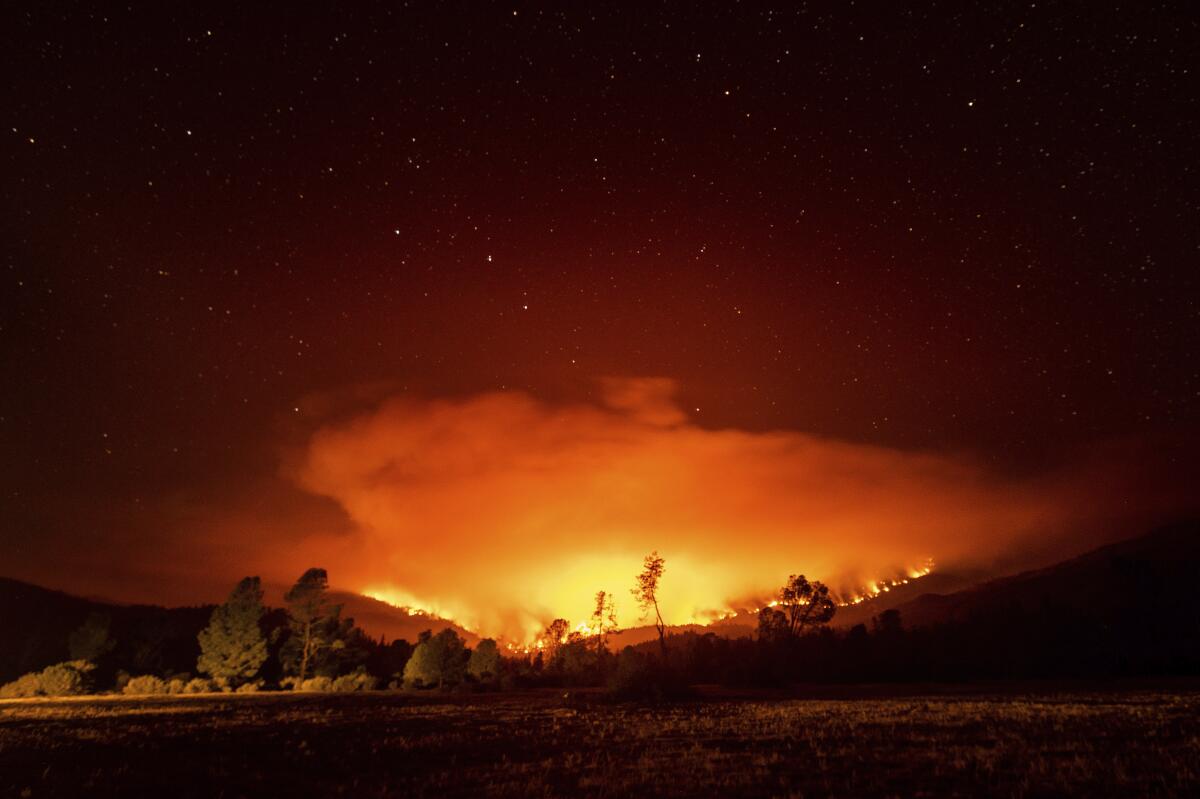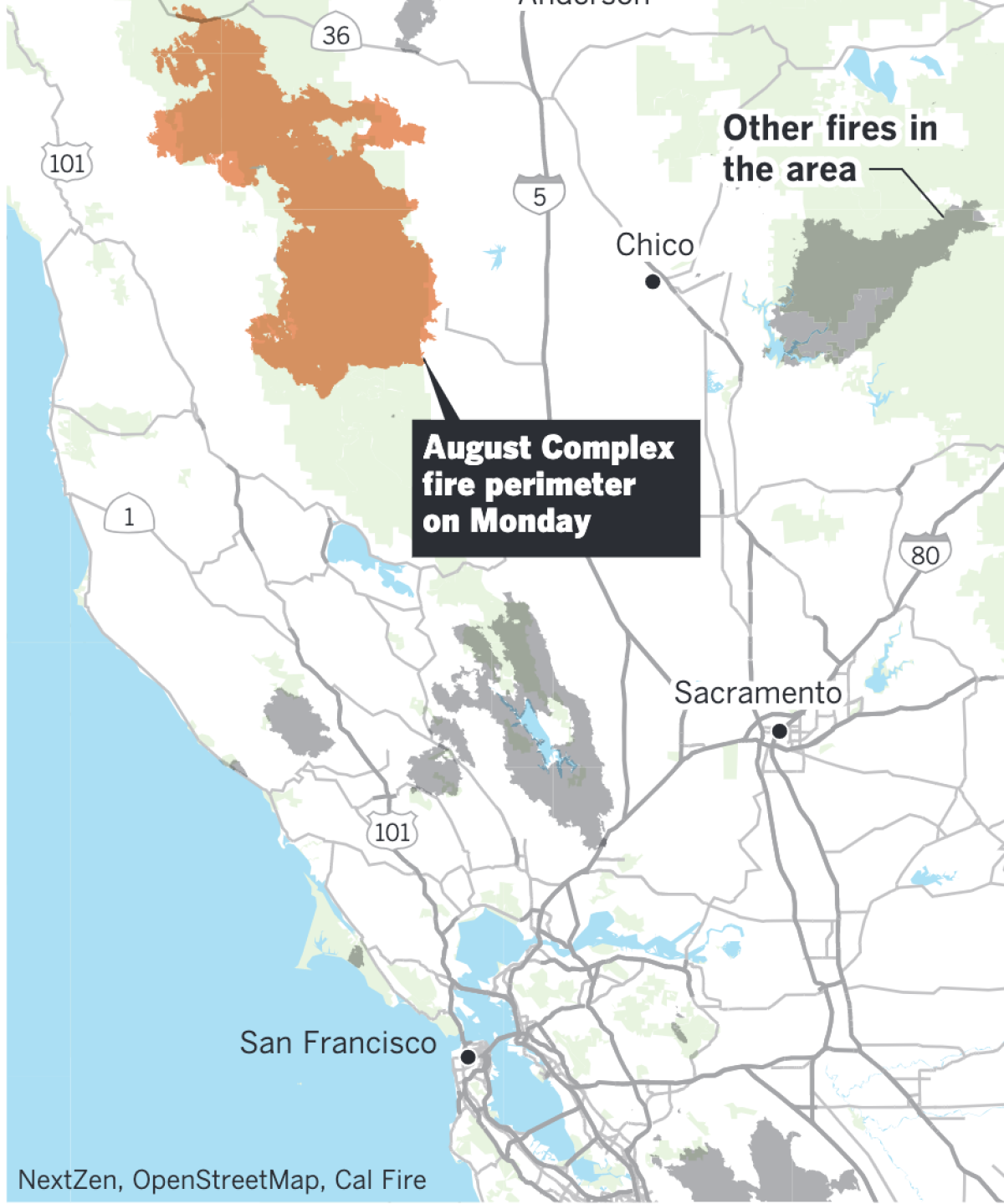The frightening implications of California’s first million-acre fire

- Share via
It was mid-August and California was experiencing yet another bout of extreme weather.
In Death Valley, the thermometer at the Furnace Creek Visitor Center displayed one of the hottest — if not the hottest — temperatures ever recorded on Earth: 130 degrees.
Up in Northern California, an unusually fierce lightning storm lighted up the skies and ignited numerous wildfires, stretching from the Salinas Valley and the Santa Cruz Mountains north into the Mendocino National Forest and beyond.
More than 12,000 lightning strikes were recorded over the next 96 hours. In the weeks that followed, 37 of those small fires morphed and merged into what was to become the largest wildfire California had ever seen: the August Complex.
On Monday, it reached “gigafire” status, burning more than 1 million acres, setting a new record for the state and offering what experts say is a terrifying window into how climate change and other factors such as mismanaged forests are worsening the state’s fire danger.
“It’s almost just kind of like a debt that we’ve accrued, and that we’re finally paying on it,” said Brandon Collins, a fire scientist at UC Berkeley.
In the 50 days since that lightning storm set the area ablaze, the August Complex has expanded into seven counties, including Mendocino, Humboldt, Trinity, Tehama, Glenn, Lake and Colusa. Even Monday, it continued to threaten communities as firefighters struggled to gain greater control of the inferno.
The sheer size of the fire is hard to fathom.
“It makes up more than all of the fires that occurred between 1932 and 1999,” Gov. Gavin Newsom said Monday. “If that’s not proof-point testament to climate change, I don’t know what is.”
The August Complex has contributed to the worst fire season California has ever recorded: 4 million acres in California have burned to date — far exceeding the previous record of more than 1.8 million set in 2018. One firefighter, Diane Jones, 63, lost her life trying to battle the blaze.
“This is a wake-up call,” said Bill Patzert, a climatologist who spent several decades at the NASA Jet Propulsion Laboratory in La Cañada Flintridge. “California burns every year, but it didn’t burn a half a century ago like it is today. The stage is evolving.”
Increased global temperatures driven by carbon emissions also contributed to 2020’s extreme fire conditions. California saw its hottest August on record, only to break at least six more temperature records in September. Fourteen of the last 21 years have also seen below-average rainfall in the state.
Combined, the factors were a recipe for creating the vast swaths of bone-dry vegetation that have fed the August Complex for weeks. The fire has burned its way through three national forests, including Mendocino, Shasta-Trinity and Six Rivers.
“I can’t remember when we got any rain last,” said Mendocino National Forest spokeswoman Punky Moore.
Moore described an endless string of hot, dry, smoky days for fire crews battling the blaze, often amid low visibility and steep, rocky terrain. Nearly 4,000 aerial and ground personnel from the California Department of Forestry and Fire Protection and the U.S. Forest Service — as well as 138 National Guard personnel and crews from as far away as Montana, Texas, Washington and New Jersey — are on hand to assist in the fight.
“There were several times when the fires doubled in size,” Moore said of the August Complex’s growth. “When they doubled in size, we knew it was going to get large.”
There are a number of reasons why the blaze got so big.
Severe bouts of lightning have struck Northern California and caused a huge number of wildfires before; it happens roughly every 15 years or so, such as during the lightning-sparked fires of June 2008 and those that formed around September 1987, said Scott Stephens, professor of fire science at UC Berkeley.
But while the 1987 and 2008 fires happened to hit mostly remote country, like in the Sierra Nevada and Klamath mountain ranges, this year the lightning also extended to the urban Bay Area.
The result was that the state was particularly stretched for firefighting manpower, and much of the firefighting attention was focused on the Bay Area, and officials could not afford more resources on more rural fires like the August Complex.
“It was just an overwhelming number of fires early. And then resources that were then stretched thin,” Stephens said. “And this one, just based on a prioritization, was given a lower priority, and it continued to get bigger and bigger.”
The mix of widespread dry lightning with the hottest August on record in California that dried out the vegetation primed the landscape for disaster.

“Climate change is predisposing the fuels into drier conditions,” Stephens said. “We know the fire season length is also increasing ... so it’s absolutely right that climate change is making this more challenging.”
A recent report in the journal Environmental Research Letters said that climate change was increasing the likelihood of extreme autumn wildfire conditions across California.
“We found that climate change has already more than doubled the frequency of extreme autumn wildfire conditions in California over the past 40 years,” coauthor Daniel Swain, a UCLA climate scientist, wrote recently.
Despite its rural origins, the legacy of the August Complex fire has been acutely felt by millions of Californians — sending huge amounts of smoke and ash that blotted the sun across the north and led to apocalyptic skies that left the San Francisco Bay Area in an orange, toxic twilight for much of Sept. 9. The Bay Area experienced a record 30 consecutive “Spare the Air” days warning of unhealthful air quality.
The plumes of smoke even “were getting down to Southern California; it’s getting to Arizona,” said Collins, the UC Berkeley fire scientist.
But the legacy of the August Complex fire may also end up being partly positive. The blaze has received less public attention not only because of the lack of destruction in major urban areas, but also because of its relatively slow rate of growth.
Unlike the North Complex fire — which killed 15 people and raced across Butte County in a single day — or the Creek fire in the Sierra National Forest, which spurred the evacuation of campers by helicopter, the slower spread of the August Complex fire may mean the flames burned less intensely and left more surviving trees.
That would set the stage for relatively more ecological benefits than a hotter, more intense fire that burns virtually everything to a moonscape, as has been the case in other California wildfires this year.
If that hypothesis ends up being true, it could show how a large — but not particularly intense — fire can be used to help sustainably manage forests.
Scientists have long warned that the unnatural suppression of forest fires for decades has caused forests to become overgrown, meaning that when fires do burn, they burn so intensely there are large expanses of wildlands that are virtually incinerated, instead of allowing the largest trees to live on, as happened more commonly before the modern era.
Scientists have long advocated for better management of forests with more prescribed burns and logging — not of the most lucrative large trees, which are fire resistant and anchor the ecosystem, but the smaller trees that have far less economic value.
The unhealthy states of California’s other forests led to horrific lasting damage to their ecosystems, possibly in ways that won’t be healed in our lifetime, if ever. In the North Complex fire, where swaths of land of 5,000 to 10,000 acres of forest have been destroyed, conifers may have been destroyed permanently and won’t return naturally.
When giant stretches of forest land are decimated by intense fire, what was once forest can end up converting into another type of landscape, such as one dominated by shrubs. And shrubs can burn more often, worsening the fire risk to California.
The hope among experts is that the devastating wildfires will help spark U.S. and state officials to enact sweeping changes needed to reduce fuels from forests so they burn less intensely.
A major challenge will be dealing with the nearly 150 million dead, drought-stressed trees in California, which fueled the rapid spread of the Creek fire in the Sierra National Forest. The burning vegetation generated a cloud so heavy with smoke and moisture it collapsed downward, causing the fire to spread in many directions.
“It’s going to require some careful but deliberate burning — intentional burning,” Collins said.
The August Complex fire is just over 50% contained and will probably continue to burn for several weeks to come.
“Everybody’s ready for a break, but everybody’s doing what they have to do,” said Christine McMorrow, a spokeswoman for Cal Fire.
As for what the record-breaking gigafire means for the future of the state so many call home — experts say it probably isn’t good.
“Now that the climate is changing, fire season is not just in the fall — it’s year-round,” Patzert said.
That means more flames, more smoke and more lost acreage are very likely in store.
“The all-natural California of John Muir is definitely in the rearview window,” he said.
More to Read
Sign up for Essential California
The most important California stories and recommendations in your inbox every morning.
You may occasionally receive promotional content from the Los Angeles Times.












